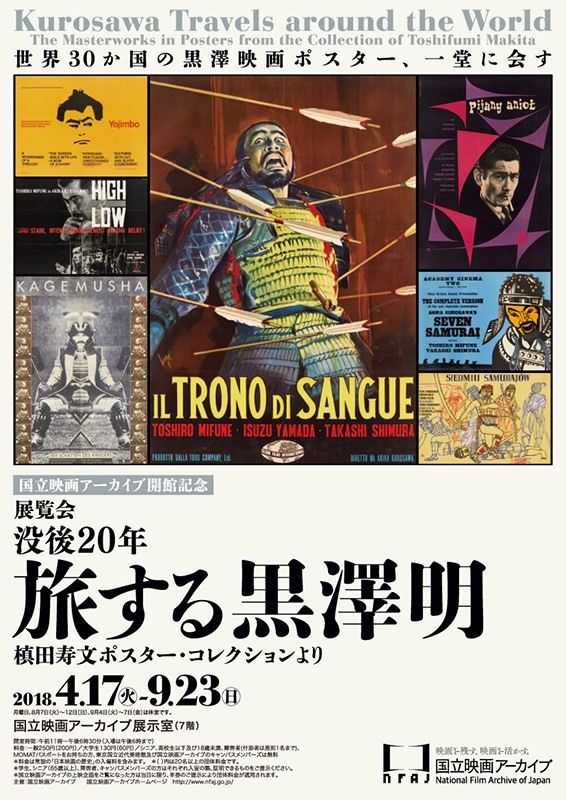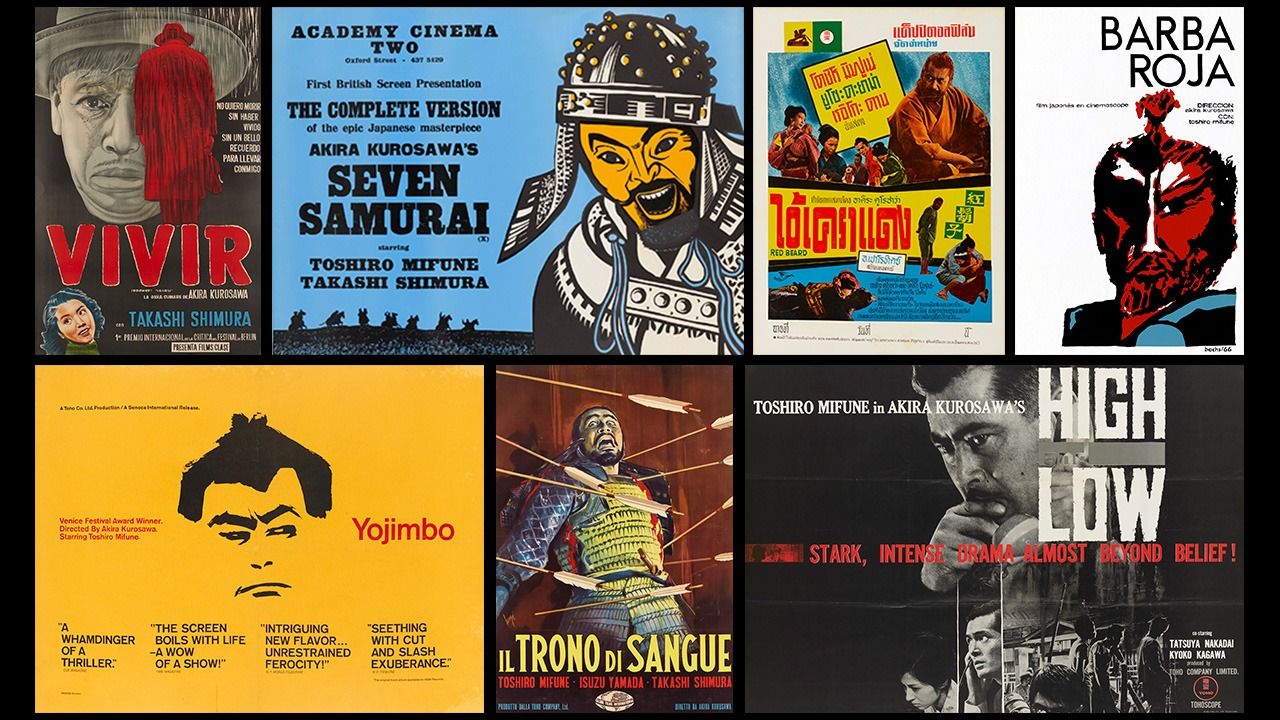
A World of Kurosawa Posters at Tokyo Exhibition
Guideto Japan
Culture- English
- 日本語
- 简体字
- 繁體字
- Français
- Español
- العربية
- Русский
In April 2018, the National Film Archive of Japan opened as a newly independent institution. Formerly the National Film Center, a part of the National Museum of Modern Art, Tokyo, the NFAJ marked its new beginning with a themed exhibition on the director Kurosawa Akira, who died 20 years ago this September.
The World Discovers Japanese Film
Kurosawa is almost certainly Japan’s best-known director. Many Japanese people know of his prizes in international competitions and the respect he has drawn from directors and actors around the world. This exhibition offers visitors a visual representation of his global standing via film posters from a wide range of countries.
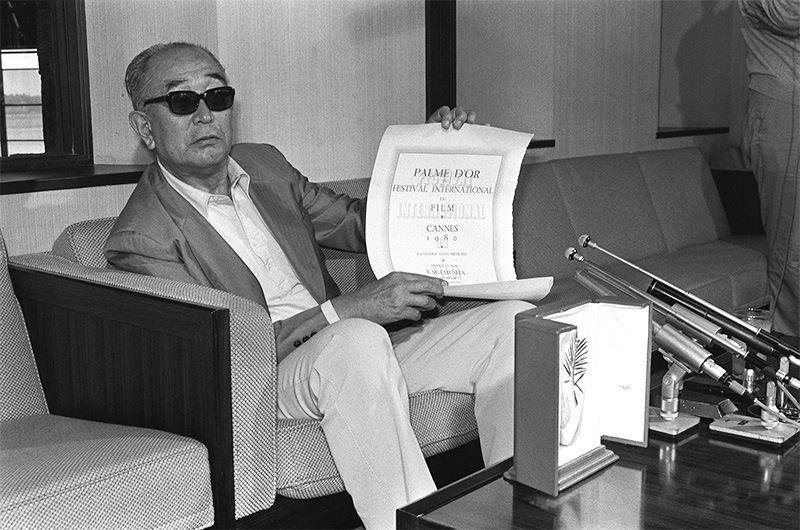 Kurosawa Akira (1910–98) at Narita Airport on May 26, 1980, after winning the Palme d’Or for Kagemusha at the Cannes Film Festival. (© Jiji)
Kurosawa Akira (1910–98) at Narita Airport on May 26, 1980, after winning the Palme d’Or for Kagemusha at the Cannes Film Festival. (© Jiji)
Kurosawa collector Makita Toshifumi has provided 84 posters for Kurosawa films from 30 countries for the exhibition. Also on display are foreign press releases, screening programs, books, and newspaper advertisements. NFAJ curator Okada Hidenori explains some of the main attractions below.
Over his career, Kurosawa directed 30 films. His career can be roughly divided into three periods. The early period comprises the 10 films from Sanshirō Sugata (1943) to Scandal (1950), when he was essentially unknown outside Japan. The middle period consists of the 13 films from Rashōmon (1950) to Red Beard (1965), when he was internationally renowned and prolific. The late period includes the 7 films from Dodeskaden (1970) to Mādadayo (1993), when Kurosawa became involved in several international coproductions.
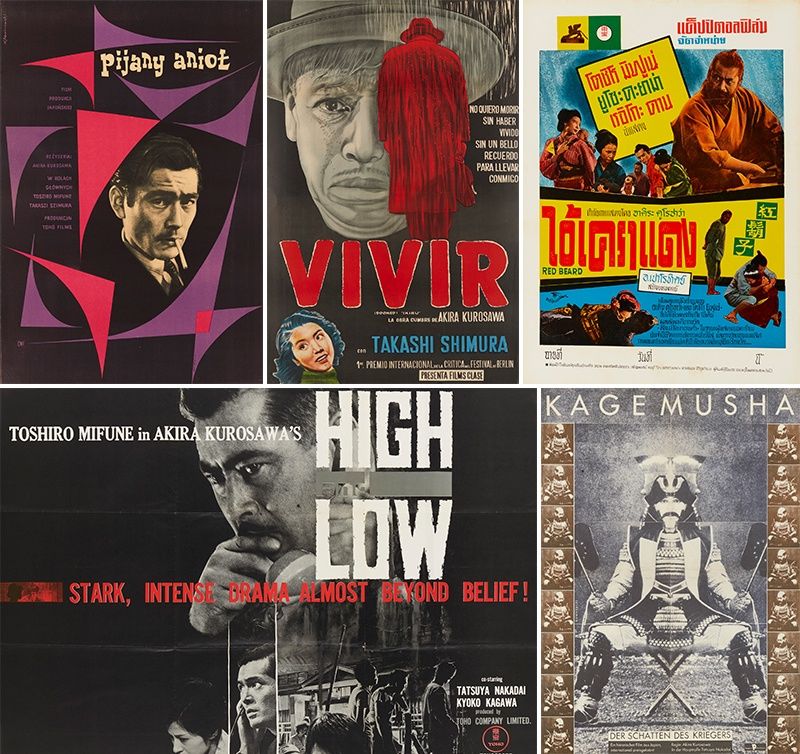 Clockwise from top left: Wladyslaw Janiszewski’s 1960 Polish poster for Drunken Angel (1948); a 1950s Argentine poster for Ikiru (1952); a Thai poster for Red Beard (1965); Otto Kummert’s 1981 East German poster for Kagemusha (1980); a 1963 British poster for High and Low (1963).
Clockwise from top left: Wladyslaw Janiszewski’s 1960 Polish poster for Drunken Angel (1948); a 1950s Argentine poster for Ikiru (1952); a Thai poster for Red Beard (1965); Otto Kummert’s 1981 East German poster for Kagemusha (1980); a 1963 British poster for High and Low (1963).
In 1951, the year after its Japanese release, Rashōmon won the Golden Lion award at the Venice Film Festival, bringing Kurosawa’s films to the attention of cinemagoers around the world. This was the first time any Japanese film had received this level of recognition, and it showed the domestic film industry that artistic works could achieve success in international competition.
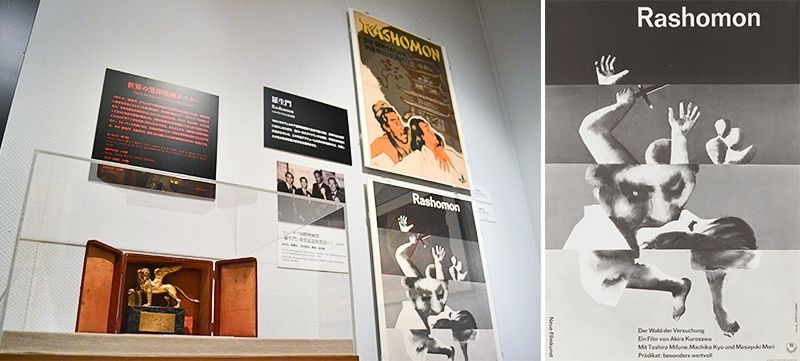 The Golden Lion award received by Rashōmon at the Venice Film Festival (bottom left) and two West German posters for the film (center). The above poster is from 1952; the lower (pictured separately at right) is a 1959 poster by Hans Hillmann.
The Golden Lion award received by Rashōmon at the Venice Film Festival (bottom left) and two West German posters for the film (center). The above poster is from 1952; the lower (pictured separately at right) is a 1959 poster by Hans Hillmann.
The 1952 poster for the West German release of Rashōmon is imbued with exoticism and the atmosphere of the “mysterious Orient.” Seven years later, a poster by rising graphic designer Hans Hillmann brings a fresh artistry to the forefront for the film’s re-release in the same country. One senses that after an initial shock, Kurosawa had become accepted and audiences had matured to his cinematographic vision.
In his composition, Hillmann eschews the straightforward techniques of run-of-the-mill posters. “The three horizontal lines that cut across the poster symbolize the distinctive narrative of the film, which consists of the different characters’ conflicting stories,” Okada says. “It demonstrates the greater understanding of Kurosawa’s work.” It is interesting to compare the nine Rashōmon posters in total from seven countries, including a Swedish one that borrows directly from a work by the artist Utamaro.
A Chaotic Battle in Bold Colors
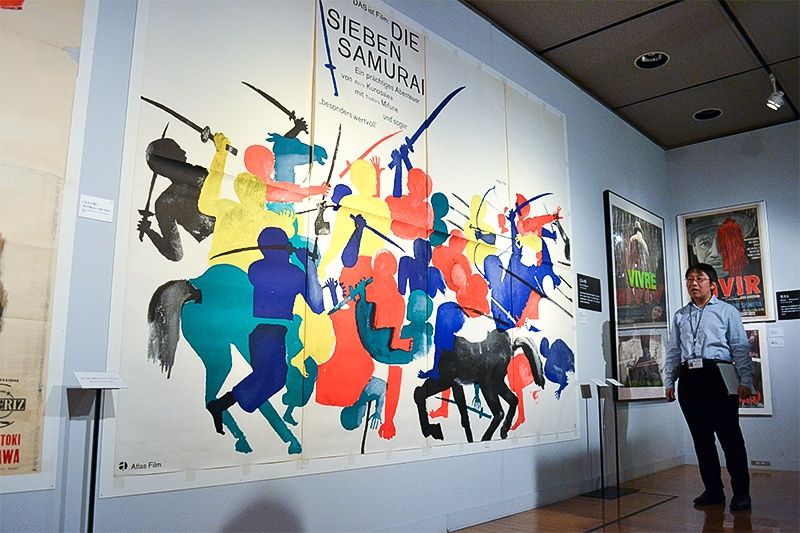 Hans Hillmann’s 1962 West German poster for Seven Samurai (1954). Okada Hidenori is pictured giving analysis.
Hans Hillmann’s 1962 West German poster for Seven Samurai (1954). Okada Hidenori is pictured giving analysis.
There are even more posters for Seven Samurai (1954), coming from 14 countries in all. The centerpiece combines eight A0 (841 x 1189 millimeters) sheets into one giant poster, and is also by the designer Hillmann. He deploys the same five bold colors as the Olympics in his depiction of the chaotic, climactic battle between the samurai and bandits. “Hillmann shows his respect for Kurosawa by reflecting the composition of the film on paper,” Okada says.
In 1960, John Sturges remade the Kurosawa classic as the Hollywood Western The Magnificent Seven. This may have influenced a Spanish poster for Seven Samurai from 1965, which recalls a classic Western landscape. Singular posters from Thailand and Iran are also well worth seeing.
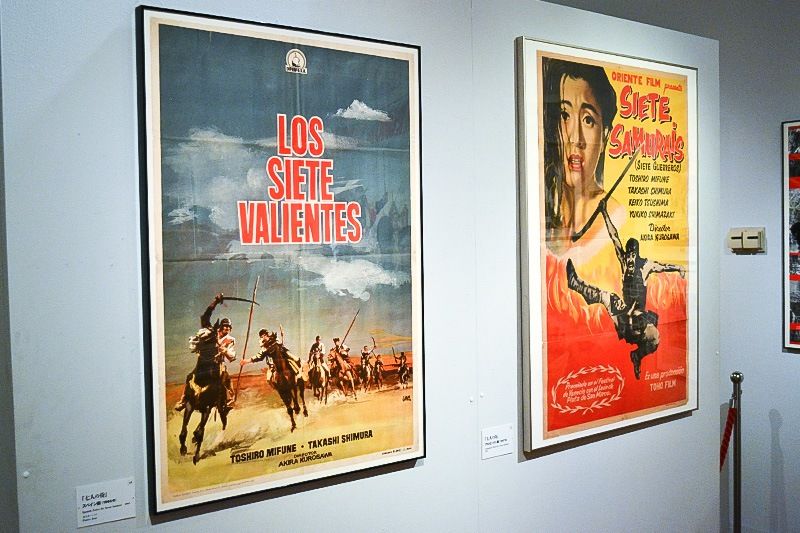 Jano’s 1965 Spanish poster for Seven Samurai (left) and an Argentine poster from 1957. Although both are in Spanish, they have different titles.
Jano’s 1965 Spanish poster for Seven Samurai (left) and an Argentine poster from 1957. Although both are in Spanish, they have different titles.
No One Like Kurosawa
One of the joys of the exhibition is comparing the countries’ diverse styles. Italian posters of the era laid emphasis on their pictorial qualities. This is expressed wonderfully in the poster for Throne of Blood (1957), in which Mifune Toshirō is showered in arrows. One imagines it takes a film still as its base, but rather than leaving it in black and white, the creator heightens the dramatic nature of the scene with blood red and other colorful shades.
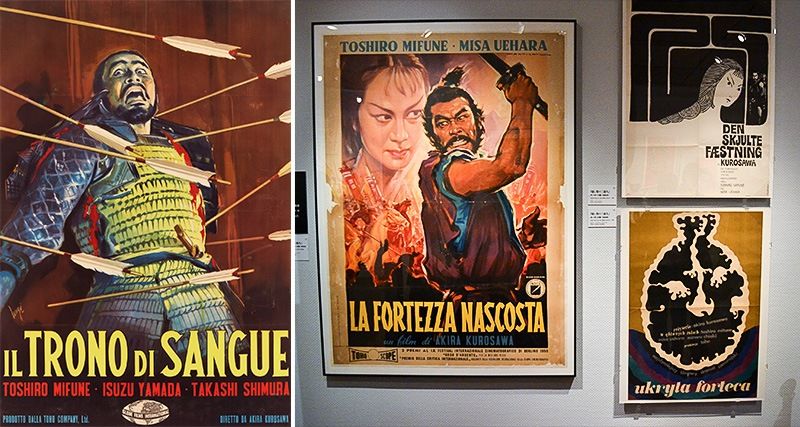 Carlantonio Longi’s 1959 Italian poster for Throne of Blood (1957; left) and posters for The Hidden Fortress (1958) from Luigi Martinati (Italy, 1960; center), Nina Schiøttz (Denmark, 1969; top right), and Andrzej Piwonski (Poland, 1968; bottom right).
Carlantonio Longi’s 1959 Italian poster for Throne of Blood (1957; left) and posters for The Hidden Fortress (1958) from Luigi Martinati (Italy, 1960; center), Nina Schiøttz (Denmark, 1969; top right), and Andrzej Piwonski (Poland, 1968; bottom right).
Eastern European posters tend toward the abstract. The Polish design for The Hidden Fortress (1958) is a classic example, looking nothing like an advertisement for an action film. In Cuba, silkscreen posters were produced in small numbers, making possible artworks like the poster for Red Beard (1965).
It is impossible to discuss Kurosawa’s films without mentioning Mifune Toshirō, whose face draws the eye of viewers in many of the exhibits. An American poster for Yōjimbō (1961) focuses on his expression alone, which appears like a paper cutout. This minimalist approach is unusual among Kurosawa posters from the United States.
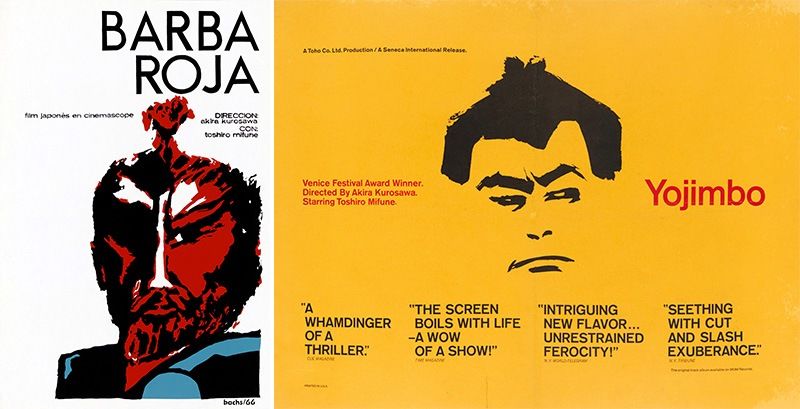 Eduardo Muñoz Bachs’ 1996 Cuban poster for Red Beard (1965; left) and a 1962 US poster for Yōjimbō (1961).
Eduardo Muñoz Bachs’ 1996 Cuban poster for Red Beard (1965; left) and a 1962 US poster for Yōjimbō (1961).
Kurosawa’s perfectionist tendencies inflated his shooting budgets to the point where the Japanese film industry struggled to keep up. After completing Red Beard, he worked on a screenplay for the Hollywood film Runaway Train, but the project did not come to fruition. Then, in late 1968 he joined pre-production for the Japanese-US war film Tora! Tora! Tora!, but dropped out after less than a month. His jacket for the film is on display at the exhibition.
The director’s first completed international coproduction was Dersu Uzala (1975), filmed in the Soviet Union. George Lucas and Francis Ford Coppola produced Kagemusha (1980), which won the Palme d’Or at the Cannes Film Festival that year. His epic Ran (1985) was a Japanese-French production, while Dreams (1990) was a Japanese-US production with the backing of Steven Spielberg. Thus, Kurosawa’s international reputation brought filming opportunities overseas.
From Kagemusha onward, Kurosawa—who once dreamed of being an artist—used his own pictures to convey his direction instructions. These were used in a French poster for Mādadayo, while a Kurosawa picture from Kagemusha appears in an official poster for the 1983 Cannes Film Festival.
 Kurosawa’s red filming jacket for Tora! Tora! Tora! is on display at center. Behind it is the official poster for the 1983 Cannes Film Festival featuring one of his pictures.
Kurosawa’s red filming jacket for Tora! Tora! Tora! is on display at center. Behind it is the official poster for the 1983 Cannes Film Festival featuring one of his pictures.
Okada says of the exhibition, “Just looking at the film posters, one can see that Kurosawa’s works were introduced to the world in many different ways. It is fascinating to see how designers from different cultural backgrounds interpreted them. Some capture the precise essence of the films, while others follow their own creative paths. Some follow their countries’ poster conventions, while others destroy them. The films themselves are set in different periods and have diverse themes. Kurosawa is the only Japanese director to bring all of these aspects together in one person.”
Kurosawa Travels Around the World: The Masterworks in Posters from the Collection of Toshifumi Makita
- Dates: April 17 to September 23, 2018
Closed on Mondays; Tuesday, August 7, to Sunday, August 12; and Tuesday, September 4, to Friday, September 7 - Venue: 7F, National Film Archive Japan, 3-7-6 Kyōbashi, Chūō, Tokyo (one-minute walk from Kyōbashi Station)
- Hours: 11:00 am to 6:30 pm (last entry 6:00 pm)
Open 11:00 am to 8:00 pm on the last Friday of each month (last entry 7:00 pm) - Admission
- Adults: ¥250
- University students: ¥130
- High school students, minors under 18, seniors 65 or over, and disabled visitors: free
- Website: http://www.nfaj.go.jp/english/
(Originally published in Japanese on June 4, 2018. Poster images courtesy the National Film Archive of Japan.)
